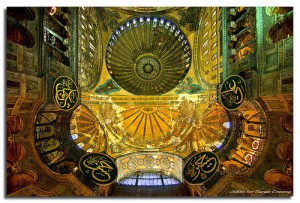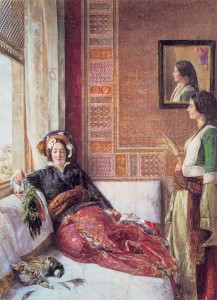I first published this post on March 19, 2011. It was a little post about some of the cool historical research I was doing at the time, for a book I was planning to write that would later become Kiss Across Chains.
This little nugget post ended up being one of the most popular posts on my site, for a very long time. Because it has now been buried under seven years of posts I thought I would bring it forward for readers who didn’t get to see it the first time, especially now that the Kiss Across Time series is back on the schedule.

It was probably inevitable I end up writing time travel romances. I’ve never been able to write anything else but romances, even when I was supposedly writing mysteries. Add in the fact that a) I’m a history nut, b) the historical romance market is all but dead in the water [note: this was in 2011 and I was referring to traditional publishing. Historical romance by indie authors is doing swimmingly well, thank you! – t.] and c) time travel romances, on the other hand…well, I managed to sell mine, so they’re apparently not quite dead, and d), (very important!) I combined my time travel with erotic urban fantasy/paranormal and those — the Kiss Across Time series — are selling very well indeed, thank you very much.
As an author and history nut, I get the best of both worlds. I get to research all sorts of interesting pockets of history, but I don’t have to research very heavily. I don’t have a thesis to defend, and I don’t have to bog down into original source documents written in original languages. I can skip across the surface of history, and dive deeper when I find something interesting. As long as my research is accurate, and the worlds I build inside my fiction authentic, then my research is adequate. Bliss, in other words.
Except for one flaw: I don’t get to actually go to those places I research. And that sad fact has impacted rather heavily on me recently. I’ve been researching for Kiss Across Chains, the third book in the Time Crossed Love series. Brody’s story, for those of you who are following the series.
My research brought me to new territory for a change. 6th Century Constantinople.
What a fascinating city!

I’ve known a bit about Constantinople for years. If you read or research much in and around the ancient times in western/eastern Europe, it’s hard to avoid hearing about the city state and its influence over politics, religion and economics from about the fifth century onwards.
When Rome fell to the barbarians around that time, the new Christian emperor of Rome, Constantine, moved the seat of the empire to Byzantium, an ancient city sitting on a promontory of land jutting into the Golden Horn — a strategic location for shipping and land routes between Europe and the East. Constantine renamed the city New Rome, and formally consecrated it on 11 May, 330. But as the city grew in influence and importance, it became known as his city, as “Constantinople,” and that has been the name for the city right up until the 20th Century.

Very early on in the city’s life, a series of double walls were built to completely surround it, including right along the seafront and many harbours. These walls were miracles of engineering at that time. They were so strongly built that Constantinople withstood all sieges and attacks for centuries, right up until the 15th century, when invading Turks defeating the city with gunpowder. It took the invention of explosives to overcome the city walls. But even today, the walls still stand, mostly intact, throughout Istanbul, which the Turks renamed their conquered city.
The cultural life of Constantinople was eye-popping. If all roads led to Rome a century or two before, all wealth and beauty poured into Constantinople. The population of Constantinople alone was staggering. During periods when the rest of Europe was struggling with plague, famine and generally poor economic times, Constantinople never had less than one million inhabitants behind its walls. The second biggest city in size anywhere in Europe estimated its population at around twenty thousand people. Constantinople simply worked on a different scale than the rest of the world.
Historians have estimated that Constantinople also controlled a lion’s share of Europe’s wealth, too. There have been reports suggesting that Constantinople contained as much as a third of the western world’s gold, coinage and valuables, all behind those walls, while the rest of the world shared the balance.

The clothes, houses and decorations of Byzantines reflected this abundance. Rich textiles, and beautiful, intricate patterns adorned everything, and clothing was layered, ornamented, colourful and expensive. The interior of the Hagia Sophia shows the incredibly rich detail and colour that Byzantines added to everything around them.
But as a citizen of Constantinople, there could be drawbacks. There was a strict layering of have’s and have-not’s. A class system controlled by economics ensured that many people were locked into their roles for life, as slaves, poor working class, or fabulously wealthy citizens with spectacularly privileged lives. There was no social insurance or social systems to help the needy or sick or poor.
Land was incredibly valuable and in high demand. The city was contained inside the walls for centuries, unable to expand, yet the population continued to grow. It was too risky to live outside the walls in perilous times, but for the poorer people, finding somewhere to live inside the walls could be difficult indeed.
Women were still considered a man’s property, and kept behind veils and closed doors, even though the  city was nominally Christian. But they were treated gently as the Christian principles suggested.
city was nominally Christian. But they were treated gently as the Christian principles suggested.
Chariot racing* was the city’s favourite past time, as a spectator sport. Even the emperor himself was a fan. Chariot races were held at the Hippodrome, which was connected to the Imperial Palace by a tunnel, which allowed the emperor to attend the races. These races were bloody and ruthless and Byzantines loved them with a passion. They bet on their favourite factions (Blue, Green, Red or White), and the superiority of the factions and who would win the races overshadowed Byzantine politics, religion and economics, as the factions and those who wanted them to win
would scheme and plot to ensure their faction gained an advantage, come race day. It sounds oddly like modern sports entertainment, with their drug scandals and game rigging exposures, doesn’t it? Think of the soccer hooliganism in

Britain, for instance…believe it or not, but Constantinople got there first. In 493, chariot racing fans rioted for three days, burning down the Hagia Sophia and the Emperor’s palace, and threatening the emperor himself. They became known as the Nika Riots, and spelled the end of chariot racing for the city.
Constantinople was a colourful city in more ways than just the clothing and decorations they used. The cultural life must have been amazing to see. I would love to be able to flip back in time for a day or two and check the city out. It sounds like New York with a ticker tape parade thrown in. Only everyone would be speaking ancient Greek.
Cool.
* As it turned out, I featured chariot racing as the major conflict in Kiss Across Chains. It was simply too full of danger and drama to not use it. The author note at the front of Kiss Across Chains is:
In Sixth Century Constantinople, the chariot races held such power over the city and its citizens, it influenced the military, politics and religion. The Emperor himself was drawn into the eternal question of whether the Greens (Prásinoi) or Blues (Vénetoi) would win.
Chariot races became the source of cheating, bribes, curses, mechanical tampering, gang warfare, street violence and murder until they finally culminated in 532 AD in five days of riots and burning, known as the Nika riots, when the Blues and the Greens worked together in a failed attempt to usurp the emperor himself.
Chariot racing fell into decline after the riots, never again to achieve the huge popularity and influence it had held for the centuries since Greece and Rome had pushed it to the fore.
But the Nika riots don’t take place until forty-three years after the events in this book.
Cheers,

.
Get the news that no one else does. Sign up for my newsletter.
For a short while, you get a bundle of ebooks, free, when you sign up, as a Starter Library. Details here.